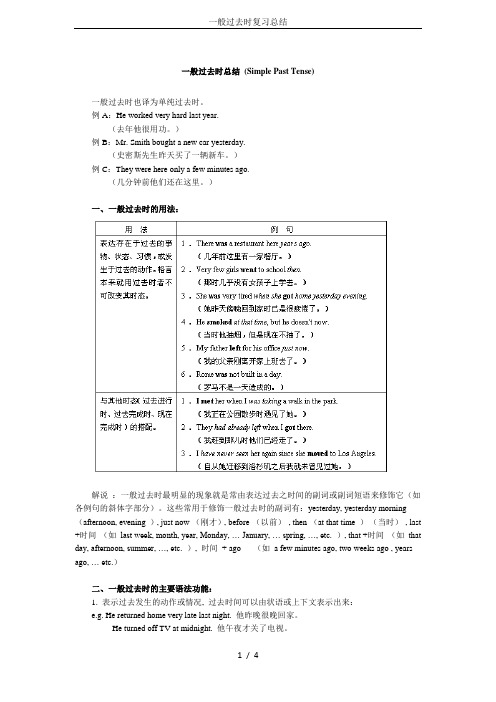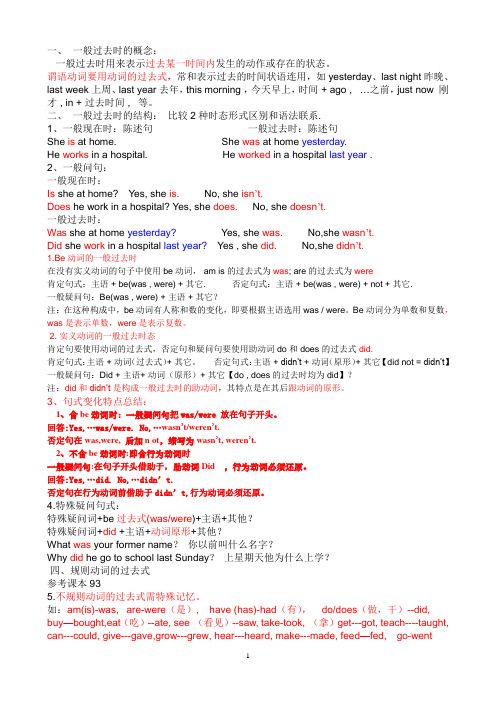一般过去时语法总结
- 格式:doc
- 大小:49.00 KB
- 文档页数:2


一般过去时总结(Simple Past Tense)一般过去时也译为单纯过去时。
例A:He worked very hard last year.(去年他很用功。
)例B:Mr. Smith bought a new car yesterday.(史密斯先生昨天买了一辆新车。
)例C:They were here only a few minutes ago.(几分钟前他们还在这里。
)一、一般过去时的用法:解说:一般过去时最明显的现象就是常由表达过去之时间的副词或副词短语来修饰它(如各例句的斜体字部分)。
这些常用于修饰一般过去时的副词有:yesterday, yesterday morning (afternoon, evening ), just now (刚才), before (以前), then (at that time )(当时), last +时间(如last week, month, year, Monday, … January, … spring, …, etc. ), that +时间(如that day, afternoon, summer, …, etc. ), 时间+ ago(如a few minutes ago, two weeks ago , years ago, … etc.)二、一般过去时的主要语法功能:1. 表示过去发生的动作或情况, 过去时间可以由状语或上下文表示出来:e.g. He returned home very late last night. 他昨晚很晚回家。
He turned off TV at midnight. 他午夜才关了电视。
他常常在午夜后才关电视。
He often turns off TV after midnight.2. 表示过去反复发生的或习惯性的动作,常和never, often, usually等状语连用。
e.g. She often swam/ went swimming last summer. 去年夏天她经常去游泳。


英语一般过去时语法知识点英语一般过去时(Simple Past Tense)是表示过去某个时间发生或存在的动作或状态的一种时态。
以下是英语一般过去时的语法知识点:1. 句子结构:主语+ 动词过去式+ 其他成分。
2. 动词过去式的构成:- 一般情况下,直接在动词原形后面加-ed。
例如:play →played,watch →watched,want →wanted。
- 以不发音的字母“e”结尾的动词,在加-ed前先去掉“e”。
例如:live →lived,change →changed。
- 以辅音字母+y结尾的动词,将y变为i再加-ed。
例如:study →studied,carry →carried。
- 一些不规则动词的过去式需要记忆,例如:go →went,eat →ate,see →saw,do →did。
3. 动词过去式的否定和疑问形式:- 否定形式:主语+ did not + 动词原形+ 其他成分。
缩写为didn't。
例如:I didn't play tennis yesterday.- 疑问形式:Did + 主语+ 动词原形+ 其他成分例如:Did you watch the movie last night?4. 一般过去时的时间状语:昨天(yesterday)、上个月(last month)、去年(last year)等表示过去某个具体时间的时间状语。
5. 一般过去时的用法:- 表示过去某个具体时间发生的动作或状态。
例如:I went to the beach yesterday.- 表示过去一段时间内发生的动作或状态。
例如:I lived in London for two years.- 表示过去习惯性的动作或状态。
例如:When I was a child, I always played with my friends.以上就是英语一般过去时的语法知识点。
记得多加练习,熟练掌握一般过去时的用法。

高考英语一般过去时知识讲解一、结构和用法在英语学习中,时态的掌握是至关重要的一环。
其中,一般过去时作为描述过去发生的动作或存在的状态的时态,具有其独特的结构和用法。
(一)一般过去时的结构1、肯定形式结构:主语 + 动词过去式 + 其他例句:She went to the park yesterday.她昨天去了公园。
规则动词过去式的构成:一般在动词原形末尾直接加上-ed,如:look looked。
以不发音的字母e结尾的动词,去e再加-ed,如:live lived。
末尾只有一个辅音字母的重读闭音节(辅元辅结构),先双写这个辅音字母,再加-ed,如:stop stopped。
末尾是辅音字母+y结尾的动词,先变y为i,然后再加-ed,如:study studied。
2、否定形式结构1:主语 + was/were + not + 其他(be动词的否定)例句:He wasn't at home this morning.他今天早上没在家。
结构2:主语 + didn't + 动词原形 + 其他(行为动词的否定)例句:I didn't know you like coffee.我之前不知道你喜欢喝咖啡。
3、一般疑问句结构1:Did + 主语 + 动词原形 + 其他?例句:Did you go to Beijing last week? 你们上周去北京了吗?结构2:Was/Were + 主语 + 表语?例句:Were you a student 10 years ago?10年前你是学生吗?4、一般过去时的特殊疑问句的构成结构:疑问词 + did + 主语 + 动词原形 + 其他?例句:What did you do last night?昨天晚上你做了什么?常见的特殊疑问词有:who, what, whose, which, when, where, why, how, how long, how much等。

一、一般过去时的概念:一般过去时用来表示过去某一时间内发生的动作或存在的状态。
谓语动词要用动词的过去式,常和表示过去的时间状语连用,如yesterday、last night昨晚、last week上周、last year去年,this morning ,今天早上,时间 + ago , …之前,just now 刚才 , in + 过去时间 , 等。
二、一般过去时的结构:比较2种时态形式区别和语法联系.1、一般现在时:陈述句一般过去时:陈述句She is at home. She was at home yesterday.He works in a hospital. He worked in a hospital last year .2、一般问句:一般现在时:Is she at home? Yes, she is.No, she isn’t.Does he work in a hospital? Yes, she does. No, she doesn’t.一般过去时:Was she at home yesterday? Yes, she was. No,she wasn’t.Did she work in a hospital last year? Yes , she did. No,she didn’t.1.Be动词的一般过去时在没有实义动词的句子中使用be动词, am is 的过去式为was; are的过去式为were肯定句式:主语 + be(was , were) + 其它. 否定句式:主语 + be(was , were) + not + 其它.一般疑问句:Be(was , were) + 主语 + 其它?注:在这种构成中,be动词有人称和数的变化,即要根据主语选用was / were。
Be动词分为单数和复数,was是表示单数,were是表示复数。
2. 实义动词的一般过去时态肯定句要使用动词的过去式,否定句和疑问句要使用助动词do和 does 的过去式 did.肯定句式:主语 + 动词(过去式)+ 其它。
语法部分(二)一般过去时一、般过去时的语法含义:表示过去某一时间或某一段时间发生的动作或存在的状态。
一般和表示过去的时间状语连用,如yesterday, yesterday morning, last Saturday,last week等。
二、一般过去式的构成:一般过去式的构成是:主语+动词的过去式。
1)动词be的过去时的形式、陈述句,疑问句及其答语:2)(1)动词be的一般过去式有两种形式,即was和were.主语是I,he,she,it以及相当于第三人称单数的名词时,谓语动词一律用was;如果主语为you,they,we以及复数名词时,谓语动词一律用were.(2)陈述句形式:主语+was/were(not)+其他。
①He/she was(not) late for school yesterday.②They/You/We were(not) here yesterday.③I was(not) at school yesterday.(3)疑问句形式及答语:Was/Were+主语+其他?Yes,人+was/were.No,人+wasn't/weren't.④—Was your sister a doctor last year?—Yes, she was./No, she wasn't.⑤—Were they here with you this morning?—Yes, they were./No, they weren't.【注意】wasn't=was not weren't=were not, was 和were与主语不构成缩写。
3)实义动词的过去式:动词的过去式的构成分为规则变化和不规则变化,规则动词的变化有下列四种情况:(1)一般情况下在动词词尾加-ed,词尾-ed在浊辅音和元音后读[d],在清辅音后读[t],在[t]、[d]音后面,词尾-ed一律读[id],如:play→played[d]clean→cleaned[d] stay→stayed[d]ask→asked [t] cook→cooked [t] watch→watched[t]need→needed[id]want→wa nted[id] visit→visited[id](2)词尾是e的动词加-d。
一般过去时语法一、一般过去时的定义一般过去时表示过去某一时候或某一段时间所发生了的事情或存在的状态。
常与过去时间yesterday, this morning, just now, a moment ago, in May, last night / year / week, once upon a time, the other day, before …, when – clause, in the past连用。
如:What did you do yesterday? 昨天你干了什么?I met Lin Tao this morning. 今天上午我会到了林涛。
I was there a moment ago. 刚才我在那儿二、用法说明1表示在过去某个时间所发生的动作或所处的状态。
常与yesterday, last week, in 1989, just now, a moment ago, the other day等连用。
如:He was here just now. 他刚才还在这里。
What did you do yesterday? 你昨天做了什么事?2在过去一段时间内的经常性或习惯性动作。
如:We often played together when we were children. 我们小时候常在一起玩。
注:表示过去经常发生的动作还可用used to 和would。
如:He used to smoke a lot, but he doesn’t now. 他过去经常抽烟,但现在不抽了。
Whenever we were in trouble, he would help us. 每当我们遇到困难,他都会帮助我们。
3表示主语过去的特征或性格。
如:At that time she was very good at English. 那时她英语学得很好。
4用在状语从句中表示过去将来。
英语语法一般过去时英语语法一般过去时一般过去时1)在确定的过去时间里所发生的动作或存在的状态。
时间状语有:yesterday, last week, an hour ago, the other day, in 1982等。
例:Where did you go just now?2)表示在过去一段时间内,经常性或习惯性的`动作。
例:When I was a child, I often played football in the street.Whenever the Browns went during their visit, they were givena warm welcome.3)句型:It is time for sb. to do sth 到时间了,该了It is time sb. did sth. 时间已迟了,早该了例:It is time for you to go to bed. 你该睡觉了。
It is time you went to bed. 你早该睡觉了。
would (had) rather sb. did sth. 宁愿某人做某事例:Id rather you came tomorrow.4)wish, wonder, think, hope 等用过去时,作试探性的询问、请求、建议等。
例:I thought you might have some. 我以为你想要一些。
【比较】一般过去时表示的动作或状态都已成为过去,现已不复存在。
Christine was an invalid all her life.(含义:她已不在人间。
)【英语语法一般过去时】。
英语一般过去时语法知识点总结(笔记完整版)这一篇就够了1 一般过去时的定义总结1.1 描述发生在过去时间的事情或者动作。
The meeting started at 9 o’clock. 会议在9点就开始了。
1.2 表示在过去时间所存在的状态。
I was sick last month. 我上个月生病了。
1.3 表示发生在过去,但是已经结束的事件或者动作。
We had hamburger for lunch. 我们午饭吃了汉堡。
看下面表格区分一般过去时一般现在时和一般将来时一般过去时I was two years old then. 我那时候2岁。
一般现在时I am two years old now. 我现在2岁。
一般将来时I will be two years old next Monday. 到下周一我就2岁了。
2. 一般过去时的表现/结构形式。
在汉语中表示过去只需要说时间就可以了,过去的时间就表示过去。
比如,我昨天吃汉堡了。
就表示过去但是在英语中,表示过去除了加时间(有时候也不加),还需要在动词上体现出来。
具体有2种表现形式。
一种是在Be动词上体现,一种是在实义动词(能够独立做谓语的动词)上体现。
2.1 Be动词的一般过去时Be动词的一般过去时视主语不同,有2种was/were。
主语为单数或者我时,用was。
I was two years old last year. 我去年2岁She was two years old last year. 她去年2岁主语为复数或你时用were。
We were in the library this morning。
早上我们在图书馆You were thin last year。
你去年比较苗条。
Be动词过去时的肯定及否定肯定句结构:主语+was/were +否定句结构:主语+was/were +not+否定与的缩写结构was not = wasn’t , were not = weren’t例句:翠花去年是个胖子Cuihua was fat last year.翠花去年不胖Cuihua was not(wasn’t) fat last year.Be 动词过去时的一般疑问句,与常规一般疑问句一样,把Be动词提前即可。
重点语法
一般过去时
1.定义:表示过去发生的事情。
2.一般过去式be动词用was,were。
3.一般过去时动词要用过去式,动词变过去式规则:
1)一般直接加ed.
2)以不发音的e结尾直接加d.
3)辅音+y结尾,把y改i+ed.
4)辅元辅,倒着数,双写最后的字母+ed.
4.一般过去时关键词:
yesterday(昨天),last year(去年),last month(上个月),last night(昨晚),last week(上周),three days ago(三天前),in+过去年份(如in 2001),this morning(今天早上)等等。
5. 不规则动词的过去式形式:
6.一般过去式一般疑问句:
be动词was,were时,把was,were放在句首。
Was there any +可数名词单数或不可数名词....?
Yes, there was./No, there wasn’t.
Were there any+可数名词复数.....?
Yes, there were./No, there weren’t.
有动词时变一般疑问句,把Did放句首,动词恢复原形。
Did+主语+动词原形....?
Yes,...did./No,...didn’t.
7.一般过去时的特殊疑问句形式:
What?did+主语+动词原形...?
回答:主语+动词过去式...。